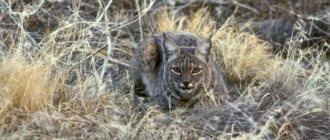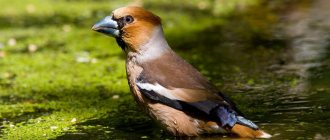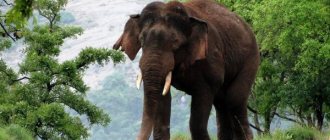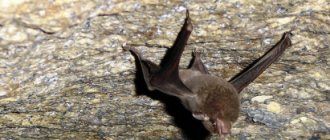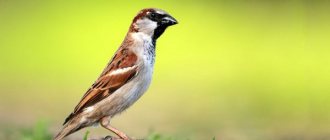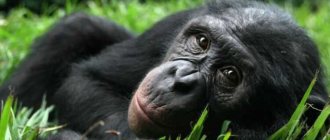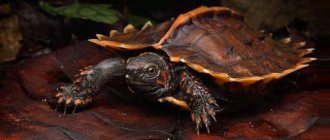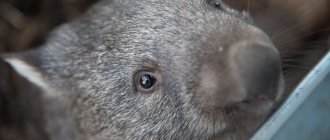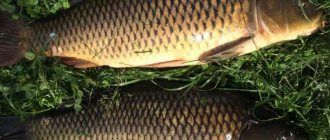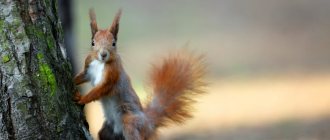- home
- Rodents
- An active and sociable degu squirrel
The exotic degu squirrel looks more like a jerboa than the jumping inhabitant of forests and parks that we are used to. Thanks to its thick undercoat and the shape of its ears, it can also be mistaken for a chinchilla. The animal comes from South America, which is why it is also called Chilean. In natural habitats, it lives together with its relatives. At home, degu quickly gets used to people and requires constant attention.
The exotic degu squirrel looks more like a jerboa
Description and character of the degu squirrel
The minimum length of the animal's body is 9 cm, and the maximum is 22 cm. The long tail ends in a cute tassel. The head has an elongated shape, the eyes are dark in color, small and widely set. There is a yellow edging around the eyes. The ears are rounded, their edges are slightly wavy. The hind legs are longer than the front legs. Degus have 8 pairs of teeth, which, like other rodents, grow throughout their lives.
The degu's coat is hard and quite dense, brown-gray or brown-yellow in color. An adult weighs 200-300 g. The Chilean squirrel in captivity lives on average 6-8 years, while in its natural habitat it lives for about a year. The lifespan of an animal depends on the characteristics of its maintenance and feeding.
The animal has an interesting feature related to its reaction to danger: if a squirrel is grabbed by the tail, it instantly sheds its skin and hides. Subsequently, it climbs into a secluded place and, using its teeth, separates the exposed part of the tail.
A person who liked a decorative squirrel so much that he decided to place it in his home should receive detailed information about the character of the animal. The animal is inquisitive and does not mind communicating with its relatives. If you get not one squirrel, but two or three, they will always be in a good-natured mood. But if the animal lives alone, it is necessary to pay a lot of attention to it - talk to it often, stroke it, trying to compensate for the lack of communication with other animals. It is advisable to gradually teach him to take food from his hands. Otherwise, the pet may become wild and show aggression towards its owner. The domestic degu squirrel moves around inside the cage mainly during the daytime. At night, the animal, as a rule, sleeps, which distinguishes it favorably from other representatives of the rodent genus.
Thanks to its thick undercoat and the shape of its ears, it can also be mistaken for a chinchilla.
When buying a degu, you should pay attention to the appearance of the animal. A healthy individual should look like this:
- eyes are clean and shiny, eyelashes are not stuck together;
- yellow teeth with clearly visible two upper incisors;
- the coat is shiny, without bald patches, close to the body;
- behavior is active, but at the same time wary.
It is better to refuse the purchase if the baby has an unkempt appearance and is inactive.
Description, photo of appearance
In appearance, they are not very similar to the squirrels that live in our latitudes. They are more likely to be confused with a jerboa or chinchilla.
Individuals are small: body sizes from 9 to 22 cm, tail length - 65-105 mm, weigh 100-500 grams. The color is often yellow-brown, sometimes gray-brown. Also, the fur can combine all three colors. The fur of the decorative squirrel is very soft and short, covered with coarse hair, and at the end there is a thick and also hard tassel.
Rules for keeping degus
Despite the relatively small size of the animals, they require sufficient space. This is explained by the mobility of proteins. You should prepare in advance a spacious cage measuring at least 60x60x60 cm. The ideal size is 120x60x100 cm. The structure should be made of stainless steel.
Other materials, such as wood or plastic, are not suitable for one reason: the animal can chew them with its sharp teeth in a matter of minutes.
It is advisable to make 2 or 3 levels inside, connecting them with ladders. A special room must be provided in the cage for the animal to spend the night. A small house can serve as such a place. In addition, you need to place a tray filled with wood shavings in the cage. It is advisable for her to cover the bottom of the cage as well. If this is not available, you can use pressed corn cobs or white sheets of paper.
Chilean degu squirrels love to hide in various shelters, so it is necessary to provide such places for them. Many owners place clay pots in the cage, small stones, tree roots or branches, along which rodents happily run. Animals need plants to sharpen their teeth on them, so it is necessary to periodically add new portions of tree branches to them. It is also recommended to install several shelves that will attract the attention of an inquisitive animal. To prevent the animal from being injured, these structures should be secured securely.
In nature, squirrels are often on the move. In cages they do not move as intensely, so a special wheel is installed in them. Moving inside it, proteins expend energy. It is necessary to take care of the placement of feeders, of which there should be several, as well as a reservoir with fresh water.
The Chilean squirrel does not like to be in direct sunlight, so the cage must be placed in a shaded place. It is necessary to ensure that the animal’s home is not located in a draft.
Habitat territories
Degu squirrels living in burrows have chosen South America as their habitat. They prefer desert or rocky areas, but can live in swampy and wooded areas. They can also settle in floodplains.
Gallery: degu squirrel (25 photos)
Character traits
Degu squirrels are very sociable burrowing animals. They dig their burrows together, creating large networks of tunnels. Despite their developed homes, rodents spend a lot of time searching for food on the surface. One group of squirrels can develop an area of 200 m2.
Communication between individuals occurs using fifteen sounds that a rodent can make, as well as using tactile, acoustic and chemical means of perception.
The period of activity is the daytime, mostly morning and evening. A group of squirrels, with a fairly developed hierarchical system, has its own territory, which they defend from the invasions of strangers.
How long Degus live depends on the territory and living conditions. In natural conditions, they extremely rarely live up to two years, but when kept at home they can live up to ten years.
Getting used to the cage
After acquiring a rodent, there is a natural desire to place it in a cage as soon as possible. It is not recommended to do this, since the animal needs some time to adapt to the surrounding reality. It is best to place the box in which the Chilean squirrel was transported next to the cage. Over time, when the animal gets used to the new environment and begins to behave more calmly, you can remove it from the carrier and place it in a cage.
It should be remembered that this must be done carefully so as not to cause unnecessary anxiety in the animal. Before this, it is recommended to place part of the bedding from the carrier in the place designated for the squirrel’s permanent residence. The degu will smell itself in the new place, which will help it cope with anxiety.
After the animal gets comfortable, it is necessary to walk it periodically. It should be allowed into a previously fenced off part of the room, freed from electrical wires, glassware and other objects that may attract the attention of degu squirrels. Some indoor plants can also pose a danger to these animals - anthurium, calla lilies, ivy, rhododendron, sansevieria, etc.
After a walk, the animal may not want to go back to the cage. In this case, you should place the structure next to it and open the door. The animal will soon come inside because it is either hungry or thirsty.
You can speed up this process by giving treats accompanied by soft whistling. The degu will remember this sound and will subsequently respond to it by running up to the feeder. If you have to catch the animal, you should under no circumstances cover it with your palm, otherwise the squirrel will be stressed. Do not grab the squirrel's tail to avoid damaging it.
Housing
Along with the purchase of a pet, you must purchase all the equipment for keeping it: a spacious enclosure, toys, a house, a sand bath and feeders. It is recommended to buy a house and toys made of wood, as the squirrel will taste everything and constantly chew on it.
The cage is created from thin metal rods. The size is determined in accordance with the dimensions of the animal and the number of individuals. The presence of plastic paraphernalia in the enclosure can have negative consequences. The chemical composition of the product will cause severe damage to the health of the rodent.
The cage should always be clean. By nature, degus are very clean creatures. They don't tolerate chaos. If the owner forgot to change the bedding or did not tidy up the cage, the pet will throw all irritants out of the cage.
Feeding and hygiene of the Chilean squirrel
Before you feed the squirrel, you need to take care of a diet suitable for it. Since we are talking about a rodent, the following products can be used:
- corn;
- crackers, previously ground;
- oat flakes;
- dried peas.
It is allowed to give the animal ready-made food, which can be purchased at pet stores, as well as hay.
The animal's diet should include fruits, vegetables and seeds at room temperature. Sweet fruits should not be given, as the animal may develop diabetes. Unripe or overripe fruits and dried fruits are undesirable. You cannot give degus milk and fermented milk products, meat and fish, and various table scraps.
Future owners of decorative squirrels will certainly be optimistic about the information that these animals do not need to be washed. The animals are clean and therefore do not need bathing. The animals are able to take care of themselves on their own with the help of ordinary sand, which must be poured into the bath. It is advisable to place a similar container with toilet filler in the corner of the cage. At the same time, you should keep the animal’s shelter clean, regularly clean it and change the bedding. However, when replacing it, you need to leave some part in place, since it is important for animals to feel the smell that is familiar to them.
You can use laundry soap to clean the tray. After completing the washing process, the tray must be wiped dry and placed in white paper. You need to put new sawdust on top, slightly diluted with the old ones.
Price and how to buy correctly
It is advisable to buy degus from trusted nurseries with a good reputation. To do this, you can consult with experienced winemakers. You can always come to the nursery and look with your own eyes at the living conditions of the animals. Of course, prices for babies in nurseries are noticeably higher than in pet stores or “from hand”. The price today ranges from 1,500 to 6,000 rubles per degu. However, it is worth remembering that this investment is not for one year. When buying a degu from a nursery, you can be sure of the physical and mental health of your future pet. There you are unlikely to buy an aggressive, weak and disease-prone individual.
If you are not satisfied with the conditions of keeping animals in the nursery, then it is better to refrain from purchasing and look for another nursery. There is no need to rush into choosing. Nowadays degus are not such a rarity and are on sale almost constantly.
When buying degus in a pet store or “from hand”, you can run into unscrupulous “breeders” who do not understand anything about the genetics of animals, breeding closely related or sick degus. Although there is a chance to buy a strong enough animal that will not bring you problems in the future. But it is worth considering that the probability of such a purchase is less than 50%. In pet stores, degus can be purchased for up to 1,500 rubles. However, you are unlikely to receive a clear description of your purchase. As a rule, sellers do not know the sex or age of degus.
You can buy degu “from hand” even cheaper – up to 1000 rubles, as agreed with the seller. Here you can bargain. Perhaps the seller will know the babies' date of birth. Where to buy and how to keep an animal, each person decides for himself. By creating decent living conditions, you can enjoy communicating and observing degus for many years. In addition, more and more necessary and useful information about degus is appearing in the media, so even inexperienced owners can cope with such a seemingly unusual animal. The main thing is to have a desire to study, make changes and improve the quality of life of your pets.
Getting offspring
Adults are considered to be degus that have reached one year of age. However, squirrels that are only 50 days old can begin the mating process. For this to happen, the animals must be on good terms with each other. If the owner wants his pet to produce offspring, he needs to take care of a suitable pair in advance. You need to purchase an individual of the opposite sex and place it with the animal that already lives at home.
You should carefully observe the behavior of the couple, because it is possible that the female and male may not get along with each other. In this case, one of them may show aggression towards their partner.
If the animals do not fight and treat each other favorably, offspring can be expected. It is recommended to remove objects from the cage that could injure the pregnant squirrel or the babies she gives birth to. These include shelves with food and a wheel.
Individuals close in blood are not suitable for mating, since the squirrels may be born weak and sick. The most suitable partners are those who are six months old. After birth, the male is placed in a separate cage. This is done to prevent re-mating. The female is ready to bear a fetus and give birth no more than once a year.
Pregnancy lasts for 90 days, after which the birth process occurs. Usually 5-6 babies are born, but sometimes their number reaches 12. There are times when only one baby squirrel is born. 4-6 weeks after receiving the offspring, the small rodents are moved: boys into one cage, girls into another. If this is not done, the young individuals will begin to mate.
Social structure and reproduction
Photo: Degu squirrels in Chile
Chilean squirrels are highly fertile and reproduce successfully both in natural conditions and in the wild. Puberty begins around the age of one and a half years. The duration of the cycle in females ranges from 7 to 23 days. The onset of estrus indicates readiness for mating. After mating, a gestation period begins, which lasts about three months. Chilean squirrels give birth to fully viable, independent babies.
One female can give birth to 3 to 9 babies. The weight of one newborn is about 15 grams. They are born sighted, covered with short, thin hair. During the first few weeks, newborn babies need breast milk. However, then they quickly switch to a general diet. Within 10-12 days they completely switch to the diet of adults. This is facilitated by parental care. Adults who raise their young in natural conditions carry lush, green vegetation into their burrows.
Animals give birth once a year, extremely rarely twice a year. The breeding season in natural conditions is seasonal. In warmer countries it occurs in autumn - mid-winter. The average lifespan of rodents in natural conditions is 10-14 months. When kept at home, when the animal is well looked after and has enough food, life expectancy increases to 7-8 years.
Determining the sex of the animal
It is important to know how to determine the sex of cubs, since male and female degus are very similar in appearance. That is why it will be difficult to do this at first glance. Sex determination should begin by raising the tail and examining the area of the body where the anus is located. The cone-shaped appendage is mistaken by some for a penis, but it contains the urethra, which is present in both sexes. Boys' genitals are hidden inside the abdominal stripe and are not visible; in girls they are also invisible. Then how to determine gender if it is not possible to examine the genitals? This is done according to the distance between the anus and the appendix, which is practically absent in females, and approximately the length of the little finger in males.
If you know the characteristics of the behavior and reproduction of animals, then keeping them at home will not cause big problems. With proper care, degus are playful, cheerful and capable of responding to their owners with devotion and love.
Nuances of nutrition
The “menu” of the Degu squirrel consists of: all kinds of herbs, including medicinal ones; roots, leaves and flowers of shrubs; plants' seeds; vegetables and tree bark.
Since the squirrel is a herbivore, its diet should contain plant food daily, including hay, leaves and grass. Plant food is necessary for rodents to fully develop.
Home conditions
When getting such an animal, you need to take care of the necessary conditions in advance. The Chilean squirrel can be considered exotic, and therefore finicky for our conditions.
It is immediately worth noting that the animal cannot be taken from above or from the sides - all because of natural reflexes to birds of prey.
